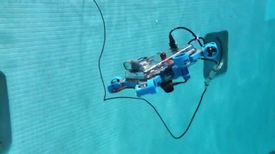AUTONOMOUS UNDERWATER VEHICLE
As part of our third year design course, myself, Chris Gravel, Bankole Adebajo, and Nicholash Bedi designed, built, and tested an autonomous underwater vehicle. This project was completed over two and a half months, from initial concept sketches, all the way to final product. I took the lead on mechanical design, while also being involved with the electrical and software components. Control was emphasized in the design, using a non-traditional six motor configuration to allow the vehicle to move in any direction as desired. This also allowed for easy course correction. Multiple sensors, including a depth sensor, accelerometer, and camera were interfaced with a Raspberry Pi to provide sensory input to the vehicle. The motors were controlled via a PWM board while depth, roll, and yaw were controlled using PID controllers with input from the sensors. A waterproof USB connector was added to allow for connection with an external controller so that this could operate as a remote controlled vehicle as well. OpenCV was used for computer vision, however time constraints on the project meant that full autonomy could not be implemented. As such, partial autonomy was the most that could be achieved. The final product controlled very nicely. and performed very well during the competition phase of the project.
























